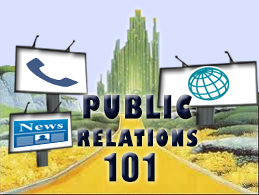Public Relations 101: Following the Yellow Brick Road

A startup’s crash course in Public Relations 101
We have found over our time working with startups that many have a strong interest in public relations activities, but through their own efforts they’ve found that it isn’t as simple as following the yellow brick road. Unfortunately, there is no single roadmap or step-by-step approach that’s guaranteed to get you the media attention you seek. Having a well-thought out plan starts with defined goals. This includes determining the types of publications where you’d like coverage and the messages you want to get across. Finding the right publications is not as difficult as finding a needle in a haystack. Identifying, developing and nurturing true relationships with the members of the media with whom you want to engage—that’s the true challenge. But with the right approach and knowledge up front, you can be on your way to achieving your PR goals.
So let’s begin our Public Relations 101 with 5 Tips for Getting Media Coverage
1. Build a Rock Solid Media List
The first place to start is choosing which journalists and publications you want to target. Concentrate your efforts on locating journalists that are passionate about startups, innovation, and your industry. Start with your dream publications. (Wall Street Journal, Inc Magazine, Entrepreneur, etc..— am I close?) Then focus on tracking down more niche or local journalists. Remember, the bigger the publication, the harder it will be to gain news coverage, so creating a diverse media list is important. Lastly, keep your list current by giving it a quarterly update when possible. Writers and editors come and go from publications, so having the right contacts will be key.
2. Pick Your Best News to Pitch
Realize that journalists are busy. They get inundated on a daily basis with media pitches through phone calls, emails, tweets, and LinkedIn messages. When considering reaching out to a member of the press, find a way to stand out from the crowd. Bring real value to the table by presenting news that matters, like your startup’s impact on a broader community or industry (for content-relevant journalists) or your latest round of funding (if the journalist covers startups and VC’s). Product launches and other ‘internal’ news can be newsworthy, but always ask yourself why the journalist will want to write about it and what value it will bring to their readers.
3. Get to Know Your Journalists
Public relations 101 isn’t just about providing journalists with insightful content for their readers. It’s about getting to know the key writers and editors at each target publication and developing a bridge to them. First, learn which journalists cover areas that relate to your news. Finding a journalist or publication enthusiastic about entrepreneurship within your industry sector may be more beneficial than someone who covers all business topics. Then determine the right medium to connect. Some journalists prefer connecting through Twitter. Others can easily be reached through a phone call. Learn their preferences, and follow them. Finally, consider creating a sense of urgency with your news by offering an embargoed press release to your top choice publications. Receiving the news before everyone else will give these journalists more time to prepare and get an edge on their competition. If you’ve never written a press release before, make sure you understand the correct formatting by looking at examples of other releases.
4. Perfect Your Pitching Strategy
Once you’ve identified your press-worthy news and your top journalists, it’s time to pitch your news to the media. Pitches are not a reiteration of your press release, but rather the key points related to your release highlighted in a way that aligns with your journalists’ interests (and more importantly, their reader’s interests). Your pitch should be customized for each journalist. For example, let’s say you write a press release about your enterprise finance product. For a journalist interested in innovation, your pitch could emphasize how your startup’s product is a never before seen technology that will disrupt the finance industry. In contrast, for a journalist who writes about the finance industry, tailor your pitch to elaborate on how your product will change how enterprises manage their finances. Both pitches still speak to your product but in different ways that will match the individual goals and overall messages of each journalist and publication.
5. Make Their Lives Easier
The easier it is for a journalist to understand what you’re pitching, the more likely they are to cover your piece—starting with the title. Journalist, Christina Belsile says, “Give us a reason to care in the title.” Try to come up with something short and catchy without being misleading. In the body of the press release, keep the most important information at the beginning, so journalists won’t have to fish through pages of content to get the gist. If you’re still not getting traction and you or someone on your team is a strong writer, consider offering to ghost write the piece for the targeted journalist. This will save them time, and they might appreciate the gesture.
It takes time to research and build a great media list and even longer to build relationships with journalists. Practice your public relations 101 skills, and learn what works for you. Just be patient, because if I remember correctly, Rome wasn’t built in a day, and neither was a public relations strategy.
For questions or assistance with your PR ideas or strategy development, contact us today for a complimentary consultation.